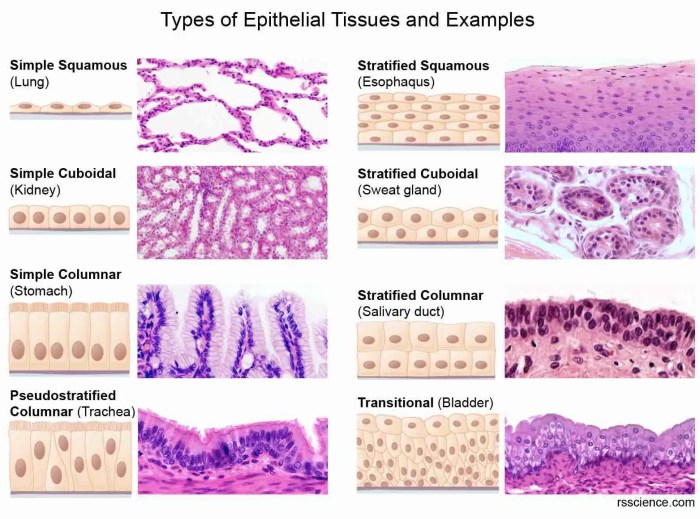Epithelial tissue biopsies worksheet answers provide a comprehensive guide to the diagnosis and interpretation of epithelial tissue biopsies. This detailed resource offers insights into the purpose, types, indications, and procedures involved in epithelial tissue biopsies, empowering healthcare professionals with the knowledge and understanding necessary for accurate diagnosis and effective patient management.
Epithelial tissue biopsies play a crucial role in identifying and characterizing a wide range of conditions affecting the epithelial tissues, which line the surfaces of organs and cavities throughout the body. By examining epithelial tissue samples under a microscope, pathologists can assess the cellular architecture, identify abnormalities, and determine the presence of disease.
1. Epithelial Tissue Biopsies
Epithelial tissue biopsies are a minimally invasive procedure used to obtain a sample of epithelial tissue for examination under a microscope. They are performed to diagnose a variety of conditions, including infections, inflammatory disorders, and cancer.
There are different types of epithelial tissue biopsies, including:
- Punch biopsy: A small circular piece of tissue is removed using a punch.
- Shave biopsy: A thin layer of tissue is removed using a scalpel or razor blade.
- Excisional biopsy: The entire lesion or a portion of it is removed.
- Fine-needle aspiration biopsy: A thin needle is inserted into the lesion to aspirate cells.
The type of biopsy performed will depend on the location and size of the lesion, as well as the suspected diagnosis.
Epithelial tissue biopsies are indicated for a variety of conditions, including:
- Skin lesions that are suspicious for cancer, such as basal cell carcinoma or squamous cell carcinoma
- Persistent infections that do not respond to treatment
- Inflammatory disorders, such as eczema or psoriasis
- Unexplained bleeding or discharge from a body orifice
- Abnormal growths or masses
2. Biopsy Procedure

The biopsy procedure is typically performed in a doctor’s office or clinic. The area to be biopsied is cleaned and numbed with a local anesthetic. The type of biopsy performed will depend on the location and size of the lesion, as well as the suspected diagnosis.
Once the biopsy is complete, the sample is sent to a laboratory for analysis. The pathologist will examine the sample under a microscope to look for any abnormalities in the cells.
It is important to handle and store the biopsy sample properly to ensure that the results are accurate. The sample should be placed in a sterile container and refrigerated or frozen until it can be processed.
3. Histological Analysis
The histological analysis of an epithelial tissue biopsy involves examining the sample under a microscope to look for any abnormalities in the cells.
The normal histological features of epithelial tissue include:
- Cells that are closely packed together
- A regular arrangement of cells
- A lack of inflammation or other abnormalities
The histological changes that can be seen in epithelial tissue biopsies include:
- Atypical cells: Cells that have an abnormal appearance or shape
- Dysplasia: A condition in which the cells are abnormal but not cancerous
- Carcinoma: A type of cancer that begins in the epithelial cells
Immunohistochemistry is a technique that can be used to identify specific proteins in the cells. This can be helpful in diagnosing certain types of cancer.
4. Interpretation of Results: Epithelial Tissue Biopsies Worksheet Answers
The interpretation of epithelial tissue biopsies is based on the histological findings.
The criteria used to interpret epithelial tissue biopsies include:
- The type of cells present
- The arrangement of the cells
- The presence of any abnormalities in the cells
The different types of epithelial tissue biopsies include:
- Benign: The biopsy shows no evidence of cancer.
- Premalignant: The biopsy shows changes in the cells that may lead to cancer.
- Malignant: The biopsy shows evidence of cancer.
The clinical significance of epithelial tissue biopsies is that they can help to diagnose a variety of conditions, including cancer. The results of the biopsy can help to guide treatment decisions.
5. Reporting Results
The results of an epithelial tissue biopsy are typically reported in a written pathology report. The report will include the following information:
- The type of biopsy performed
- The location of the biopsy
- The histological findings
- The interpretation of the results
It is important for the pathology report to be clear and concise. The report should be written in a way that is easy for the doctor and patient to understand.
There are ethical considerations in reporting epithelial tissue biopsy results. The doctor should discuss the results with the patient in a sensitive and compassionate manner. The patient should be given the opportunity to ask questions and to understand the implications of the results.
6. Quality Assurance

Quality assurance is important in epithelial tissue biopsies to ensure that the results are accurate and reliable.
The different quality assurance measures that can be implemented include:
- Using standardized techniques for performing biopsies
- Ensuring that the samples are properly handled and stored
- Having the biopsies interpreted by experienced pathologists
- Participating in quality assurance programs
Accreditation is a process that ensures that a laboratory meets certain standards of quality. Accredited laboratories are more likely to produce accurate and reliable results.
FAQ Summary
What are the different types of epithelial tissue biopsies?
There are several types of epithelial tissue biopsies, including punch biopsy, incisional biopsy, and excisional biopsy.
What are the indications for epithelial tissue biopsies?
Epithelial tissue biopsies are indicated when there is a suspicion of disease or abnormality in the epithelial tissues.
How are epithelial tissue samples collected?
Epithelial tissue samples can be collected using various methods, such as scraping, brushing, or needle aspiration.